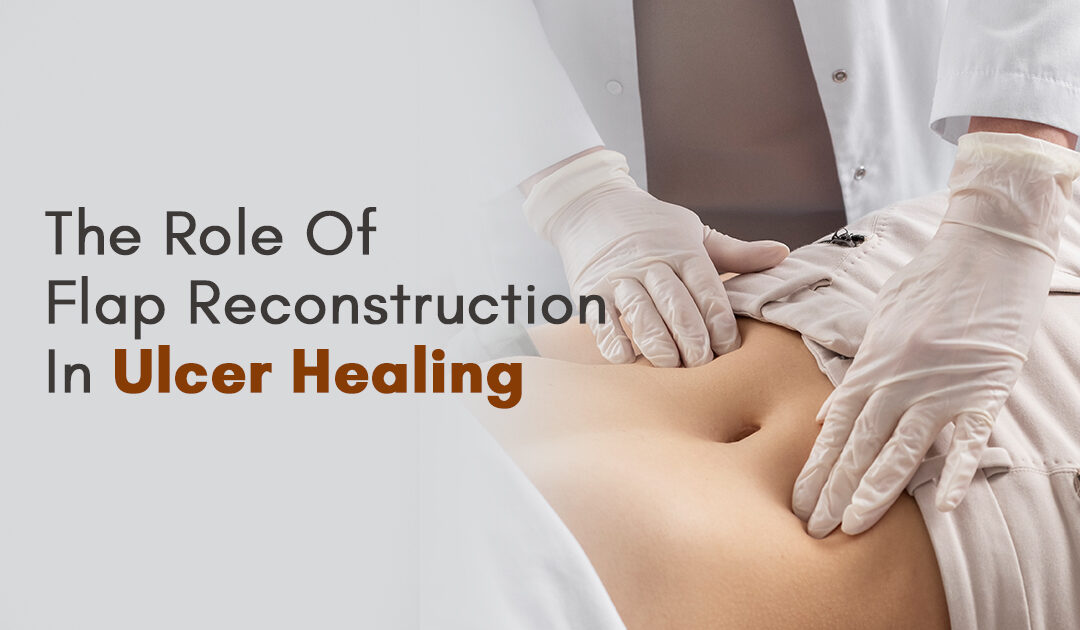Let’s be honest—ulcers are extremely difficult to deal with. Characterized by a sore or a break in the skin or mucuous membranes, ulcers may happen in any region of your body, be it internal or external. There are different kinds of ulcers, which include:
- Skin Ulcers: These ulcers are open sores and also the topic of the discussion in the blog. These are sores caused due to persistent pressure, resulting in damage to the skin and tissues. Often affecting those with less mobility, these ulcers can be managed by a treatment known as flap reconstruction.
- Peptic Ulcers: These occur on the stomach lining, esophagus or duodenum, which is the primary region of the small intestine. They are the consequence of an infection with the bacterium called Helicobacter pylori or regular use of non-steroidal anti-inflammatory drugs (NSAIDs).
- Venous Leg Ulcers: These affect the lower region of the legs and are caused due to issues with the blood flow in the veins or venous insufficiency.
- Arterial Ulcers: Less common than the other ulcers, these are caused because of insufficient blood flow in the arterial region. They are often associated with peripheral artery disease.
All these ulcers, however, share common factors such as excessive pain, slow healing, and risk of complications. Since ulcer healing takes long and can impact heavily on healthcare costs and societal burdens, flap reconstruction is recommended.
What is Flap Reconstruction?
A surgical procedure performed to treat ulcers, especially diabetic foot and pressure ulcers, is called flap reconstruction. The procedure involves transferring a healthy, well-vascularized tissue, also known as a flap, from a donor site to the ulcer site. It is performed primarily to make sure there is enhanced coverage, necessary padding, and improved blood supply in comparison to skin grafts or natural healing.
The goals of flap reconstructions in case of ulcers are:
- To gain long-lasting and sustainable closure of the wound.
- To eliminate if there is any dead space and fill the cavities or gaps in the wound.
- To compensate for the irregular blood supply and promote healing in that region.
- To prevent excessive pressure on the edges of the wound, which may cause the wound to open (dehiscence).
- To offer padding in extremely bony areas so there is no recurrence of ulcers.
- To prevent further complications such as sepsis and fluid or protein loss and reduce the risk of infection in the bones, known as osteomyelitis.
- To enhance physical appearance and bodily hygiene.
- To prevent the possibility of chronic ulcers known as Marjorin ulcers.
What are The Flaps Used in Ulcer Flap Reconstruction?
Several factors, such as the location of the ulcer, its size and depth, and the overall wellbeing of the patient, come into play while deciding the flap. The common kinds of flaps are:
- Local Flaps: This technique includes harvesting tissue from a nearby area to fill the defect. These flaps frequently maintain their initial blood supply. Examples consist of rotation flaps, which are semicircular flaps turned around a pivot point; advancement flaps, in which tissue is shifted forward in a straight path (e.g., V-Y advancement flaps); and transposition flaps, which are rectangular flaps rotated over an intervening space (e.g., bilobed flap).
- Regional Flaps: This involves harvesting tissue from a close vicinity, potentially encompassing deeper structures like muscle. These flaps rely on a particular blood vessel. Various kinds of regional flaps exist, such as muscle flaps that utilize muscle tissue (e.g., gluteus maximus flap for sacral ulcers), musculocutaneous flaps that consist of muscle along with surrounding skin and fat (e.g., latissimus dorsi flap), and fasciocutaneous flaps that incorporate fascia (a connective tissue layer) and the skin and fat above it.
- Distant Flaps (Free Flaps): These involve harvesting tissue from a remote area of the body and necessitate microsurgery to reconnect the blood vessels at the site of the recipient. These flaps are utilized for intricate cases when local or regional flaps cannot be applied. They provide a remedy for major or challenging ulcers, facilitating reconstruction and recovery.
The surgical procedure of flap reconstruction includes assessment and planning of the patient’s health, flap elevation, flap transfer and inset, donor site closure and drainage to stop collection of the fluids (hematoma or seroma).
The postoperative care and healing in flap reconstruction of the ulcers consists of resting for long periods, taking care of the wounds by keeping them dry, regularly monitoring if the blood flow is regular and staying patient through the recovery.
If you’re experiencing severe sores with tissue damage that seem non-healing and infectious, schedule an appointment with us today for prompt evaluation and treatment for your ulcers.

